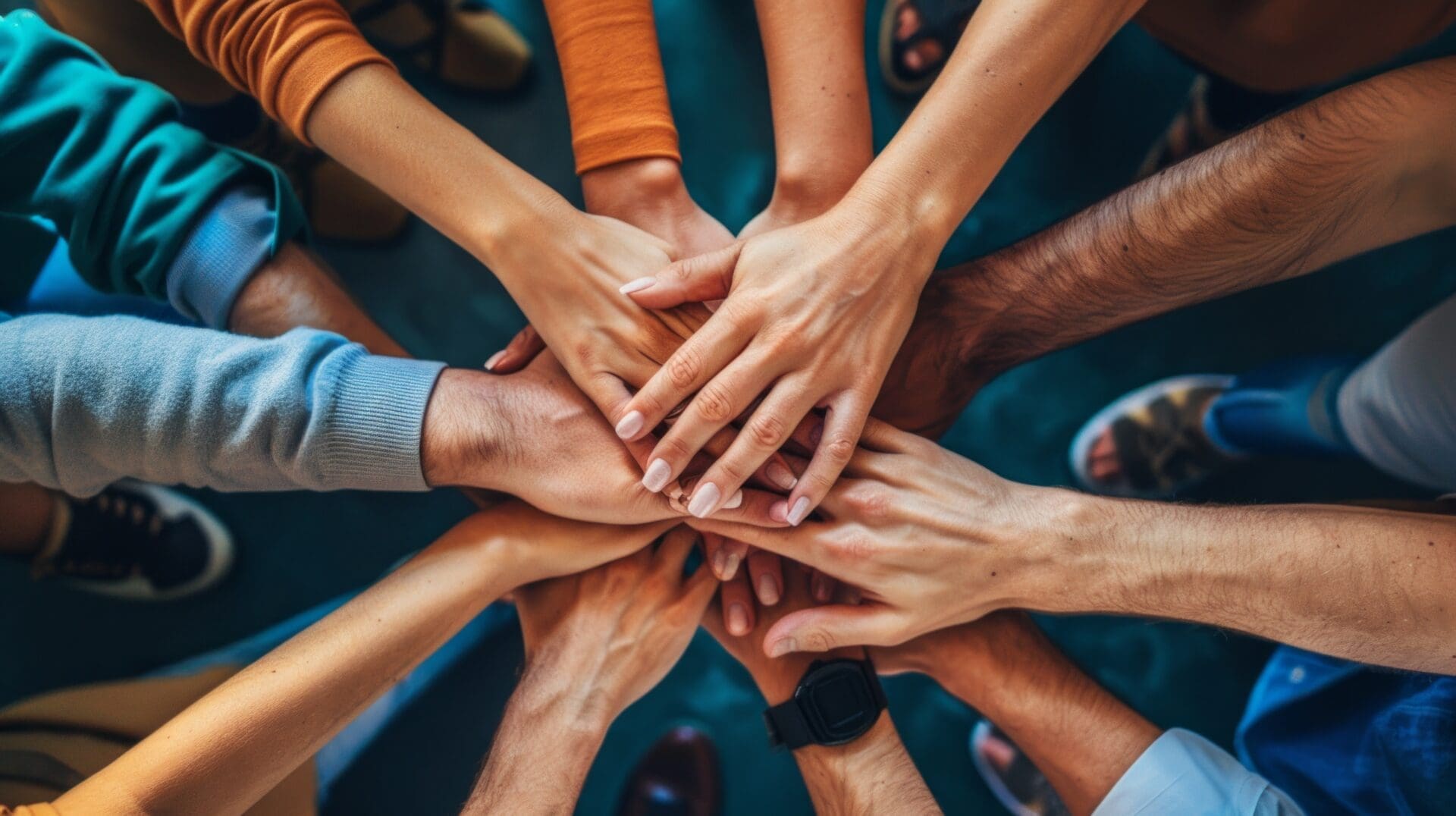
Culture and Health Wellness
Employee Coaching & Training
September 19, 2025
Crocrodile syndrome or… the law of obsolescence!
When the lifespan of skills erodes
In an ever-changing world, where digitalization, artificial intelligence, globalization of markets, rising competition and scientific advances intersect, professional skills are evolving at an unprecedented speed. The business environment, highly volatile and subject to the dynamics of PESTEL, is causing profound upheavals in employment models as well as in the ways of working. In this context, skills development is no longer a simple HR lever: it is becoming a decisive strategic issue, conditioning both the competitiveness and sustainability of organizations, but also the employability, performance and sustainable mobilization of employees.
A report by the OECD (Organisation for Economic Co-operation and Development) reveals a striking finding: the average lifespan of a skill is now estimated at only two years, whereas it reached thirty years in 1987. This shortening, the result of the constant rise of new technologies and their accelerated renewal, illustrates the phenomenon of rapid obsolescence of skills. This is putting increasing pressure on organizations to make continuous learning a pillar of their strategy to remain competitive and resilient.
The figures speak for themselves:
- 86% of key competencies could change by 2030 (World Economic Forum, 2025)
- 44% will need to be updated in the next five years (World Economic Forum, 2023)
- On average, 39% of workers’ current skills will be transformed or made obsolete by 2030 (Government of Quebec, 2025)
Crocodile syndrome: a mouth that opens over time
Crocrodile syndrome illustrates this growing mismatch between the skills required by the market and those actually mastered by workers. Initially, the gap is minimal. But over time, requirements change, jobs change, and stagnant skills become obsolete. This is where the crocodile opens its mouth wide: the inadequacy deepens, performance decreases, and employability deteriorates. Thus, the larger this gap, the more likely the organization is to lose its competitive edge. And the longer the situation lasts, the more difficult it becomes to catch up: the necessary efforts intensify, increasing the vulnerability of the company and, in turn, that of its employees.
Conceptualized by Dominique Bouteiller in 1997, this model postulates that the organization is therefore influenced by two interacting phenomena: the law of obsolescence and the inflation of the skills required:
- The law of obsolescence : Skills developed in an organization are biodegradable: they gradually lose their usefulness until they become obsolete. It is therefore the insufficiency of the up-to-date knowledge or skills necessary for a worker to continue to perform well in his current or future professional activity.
- Skills inflation : The nature of today’s jobs requires ever more advanced skills, while organizational changes bring new requirements in terms of skills and knowledge.
This dynamic highlights the major challenge of lifelong learning, which is essential to avoid widening the gap between available and required skills.
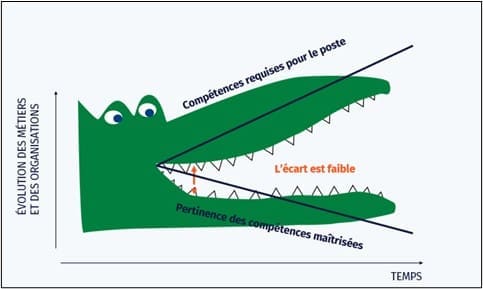
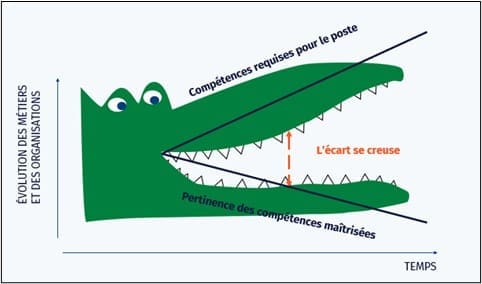
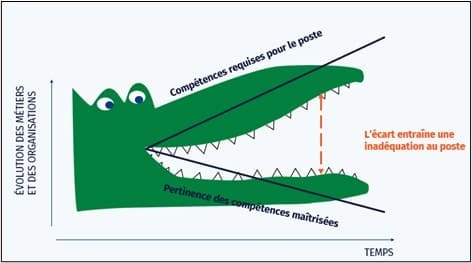
The growing impact across three levels of gap:
Level 1: a slight offset
At the start, the gap remained limited. A few one-off training courses, targeted at technical knowledge or new practices, are enough to keep the organisation in the race.
Level 2: a worrying gap
When technological and organizational changes accelerate, the gap between current skills and real needs widens. Training plans must then be more ambitious, continuous and strategic to prevent teams from feeling overwhelmed.
Level 3: Mouth Wide Open
If nothing is done, the gap becomes so vast that upgrading requires heavy investments, precious time and considerable energy. Organizations that wait too long face a major risk: seeing their employees locked into the “wrong side” of the crocodile, threatened by obsolescence and a lasting loss of competitiveness.
Turning risk into opportunity
In short, you will have understood: this phenomenon is not a simple metaphor. It’s a signal. The sooner companies invest in the continuous development of skills capital, the more they will keep the crocodile’s mouth ajar… and will remain able to navigate with agility in a constantly changing world.
Levers of action to counter the obsolescence of skills:
- Identify critical positions
- Define strategies for the transfer and maintenance of skills
- Skills Transfer Plan
- Invest in tools and platforms adapted to skills management and promote transfer, retention and dissemination
- Valuing learning and supporting skills transfer initiatives
- Promotion of a culture of training and reinforcement of learning anchoring strategies (practical exercises, discussion groups, feedback, mentoring, coaching, co-development, etc.).
- Reducing the time between training and application (just in time learning principle)
Therefore, these organizational actions make it possible to activate a virtuous circle of skills capital development:
HR Investment → Increased Efficiency → Better Products → Satisfied Customers → Driven Demand → Profitability → Competitiveness
Learning to learn: the only skill that doesn’t wear out
Therefore, focusing on continuous learning means making competence much more than a know-how: it is making it a real lever for transformation, mobilization and performance. It’s about equipping your organization with the foundation to stay relevant, innovative, and competitive in an environment where change is the only constant. Thus, crocodile syndrome is not inevitable: it acts as an alarm signal, reminding us that the world is moving faster than our skills. By putting learning at the heart of your practices, you are not only pushing back obsolescence: you are turning this challenge into an opportunity for innovation, resilience and sustainable growth.
So, what are you waiting for to make continuous learning not an option, but the keystone of your talent development and the success of your organization?
References
Government of Quebec. (2025, February 28). Report on the future of employment 2025. Ministry of Economy, Innovation and Energy. https://www.economie.gouv.qc.ca/objectifs/informer/vecteurs/vecteurs-economie-et-innovation-detail/rapport-sur-lavenir-de-lemploi-2025.
OECD. (2023). OECD Skills Outlook 2023. Organisation for Economic Co-operation and Development. https://www.oecd.org/fr/publications/perspectives-de-l-ocde-sur-les-competences-2023_fe76e556-fr.html.
World Economic Forum. (2023). The Future of Jobs Report 2023. https://www.weforum.org/publications/the-future-of-jobs-report-2023.
World Economic Forum. (2025). The Future of Jobs Report 2025. https://www.weforum.org/publications/the-future-of-jobs-report-2025/digest/.
Vicky Guérin, CRHA
Human Resources Consultant
Schedule a connection callAdvice Centre
Discover more inspiring content
Find out how our methodology has transformed companies from different sectors. Each article is proof of our expertise.

Performance Management, Performance Management
Nutrition and Workplace Productivity: An Often-Overlooked HR Priority.
Discover how nutrition impacts workplace productivity and how HR teams can integrate simple, evidence-based strategies into wellness programs.

HR technology
How can an artificial intelligence governance guide help secure your HR practices in SMEs?
Discover how to implement ethical and secure artificial intelligence governance in your HR practices using practical tools.

News & Editorials
Summer Quiz: What kind of leader are you?
Take a break and discover your leadership style. This fun summer quiz offers fresh insight to boost your self-awareness and daily impact.

Legal compliance
Pay Equity: A Legal Requirement and Strategic Lever
Rendez l’équité salariale simple et stratégique grâce à un accompagnement expert qui assure conformité, rigueur et transformation positive.

Employee Coaching & Training, Employee Coaching & Training
Why is everyone talking about collective intelligence?
Where does the enthusiasm for collective intelligence come from? Discover how it’s transforming practices, teams, and organizations from within.

Employee Coaching & Training
What is collective facilitation ?
Discover how facilitating collective intelligence enhances creativity, engagement, and performance in teams undergoing transformation.

News & Editorials, News & Editorials
Maximizing Quebec Grants: A Strategic Lever for Businesses and Organizations.
An HR grant can fund your transformation, HR optimization, and organizational development projects. Find out how to make the most of it.
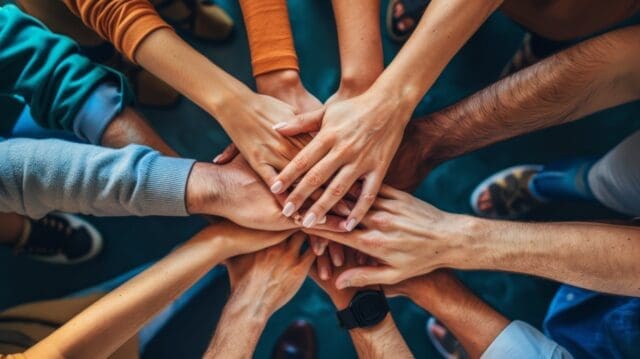
Culture and Health Wellness
From Conceptualizing to Putting the ‘’Popcorn Brain Theory’’ into Practice
Discover the Pop-Corn Brain theory and its impact on creativity and productivity in the workplace.

Recruitment & Employer Brand
The Work-Vacation Policy: A Strategic Advantage for companies
Learn how a work-vacation policy can improve employee satisfaction and enhance your company's attractiveness.

Recruitment & Employer Brand
Human resources outsourcing: when and why?
Discover the benefits of HR outsourcing to lighten your workload and benefit from cutting-edge expertise in human resources management.

Equity, diversity, and inclusion
Black History Month: Confronting Victimization and Workplace RealitiesBlack History Month: Between Victimization and Corporate Reality
Black History Month: reflections on the challenges and successes of black professionals in the professional world.

Culture and Health Wellness, Performance Management
Disconnecting at work isn’t just a question of technological disruption!
Explore the impact of disconnecting at work on employees and companies. How can this initiative improve health and productivity at work?